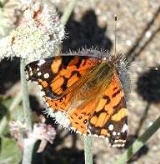
West Coast Lady
Encyclopedia
The West Coast Lady is one of three North America
n species of brush-footed
butterflies known colloquially as the "painted ladies". V. annabella occurs throughout much of the western US and south western Canada. The other two species are the cosmopolitan Vanessa cardui
(Painted Lady) and the eastern Vanessa virginiensis (American Painted Lady). This species has also been considered a subspecies of the South America
n Vanessa carye, and is frequently misspelled as anabella.
 Aside from general differences in distribution, V. annabella can be distinguished from the other two painted ladies of North America as follows:
Aside from general differences in distribution, V. annabella can be distinguished from the other two painted ladies of North America as follows:
Most conspicuously, it lacks obvious ventral eyespots on the hindwings; there are 2 large ones in V. virginiensis and 4 small ones in V. cardui. Like the latter, it also lacks a white dot in the pinkish/orange subapical field of the ventral/dorsal forewings. Its upperwing coloration has the purest orange of the three; especially the American Painted Lady is usually quite reddish.
A less reliable indicator is the row of black eyespots on the dorsal submarginal hindwing. These are usually of roughly equal size in V. cardui and lack blue centers, though the summer morph may have a few tiny ones. In the other two, usually 2 eyespots are larger and have more conspicuous blue centers. In V. virginiensis, these normally are the spot at each end of the row, whereas in the present species it is the 2 middle ones.
North America
North America is a continent wholly within the Northern Hemisphere and almost wholly within the Western Hemisphere. It is also considered a northern subcontinent of the Americas...
n species of brush-footed
Nymphalidae
The Nymphalidae is a family of about 5,000 species of butterflies which are distributed throughout most of the world. These are usually medium sized to large butterflies. Most species have a reduced pair of forelegs and many hold their colourful wings flat when resting. They are also called...
butterflies known colloquially as the "painted ladies". V. annabella occurs throughout much of the western US and south western Canada. The other two species are the cosmopolitan Vanessa cardui
Vanessa cardui
Vanessa cardui is a well-known colourful butterfly, known as the Painted Lady, or in North America as the Cosmopolitan. This butterfly has a strange pattern of flying in a sort of screw shape.-Distribution:...
(Painted Lady) and the eastern Vanessa virginiensis (American Painted Lady). This species has also been considered a subspecies of the South America
South America
South America is a continent situated in the Western Hemisphere, mostly in the Southern Hemisphere, with a relatively small portion in the Northern Hemisphere. The continent is also considered a subcontinent of the Americas. It is bordered on the west by the Pacific Ocean and on the north and east...
n Vanessa carye, and is frequently misspelled as anabella.
Distinguishing features

Most conspicuously, it lacks obvious ventral eyespots on the hindwings; there are 2 large ones in V. virginiensis and 4 small ones in V. cardui. Like the latter, it also lacks a white dot in the pinkish/orange subapical field of the ventral/dorsal forewings. Its upperwing coloration has the purest orange of the three; especially the American Painted Lady is usually quite reddish.
A less reliable indicator is the row of black eyespots on the dorsal submarginal hindwing. These are usually of roughly equal size in V. cardui and lack blue centers, though the summer morph may have a few tiny ones. In the other two, usually 2 eyespots are larger and have more conspicuous blue centers. In V. virginiensis, these normally are the spot at each end of the row, whereas in the present species it is the 2 middle ones.
- See also Painted Lady

